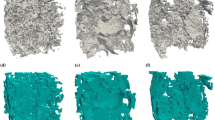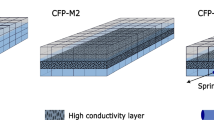Abstract
Three-dimensional 3-D Large eddy simulation (LES) has become a powerful tool to investigate evolution and structure of gravity currents, especially for cases (e.g., high Reynolds number flows, flows with massive separation) where 3-D Direct numerical simulation using non-dissipative viscous solvers is computationally too expensive. In this paper we briefly review some important results obtained based on high-resolution 3-D LES of bottom-propagating compositional Boussinesq currents in lock-exchange configurations. LES was used to provide a detailed description of the structure of the current, to discuss the role of the large-scale coherent structures, and to predict the evolution of the front velocity over the different stages of the current propagation. Three main types of lock-exchange flows are considered: (1) currents with a high volume of release (HVR) and a low volume of release (LVR) propagating in a channel with a smooth horizontal bed; (2) HVR and LVR currents propagating in a horizontal channel containing a porous layer; and (3) currents propagating in a horizontal channel containing an array of bottom obstacles (2-D dunes and ribs). The simulations are performed using non-dissipative numerical algorithms and sub-grid scale models that predict a zero eddy viscosity in regions where the turbulence is negligible. Experimental data is used to validate LES predictions. LES results show that in most cases the evolution of the front velocity is consistent with that predicted based on shallow-flow theory. LES flow fields are then used to estimate important quantities (e.g., bed friction velocity, sediment entrainment capacity) that are very difficult to obtain from experiments and to understand how the structure and evolution of the current change because of the additional drag induced by obstacles present within the channel or at the channel bed. The paper also discusses how the evolution and structure of the current change as the Reynolds number is increased to values that are relevant for gravity currents encountered in geosciences and environmental engineering applications.















Similar content being viewed by others
References
Bonometti T, Ungarish M, Balachandar S (2011) A numerical investigation of constant volume non-Boussinesq gravity currents in deep ambient. J Fluid Mech 673:574–602
Bonometti T, Balachandar S, Magnaudet J (2008) Wall effects in non-Boussinesq density currents. J Fluid Mech 616:445–475
Britter RE, Simpson JE (1978) Experiments on the dynamics of a gravity current head. J Fluid Mech 88:223–240
Cantero MI, Lee JR, Balachandar S, Garcia MH (2007) On the front velocity of gravity currents. J Fluid Mech 586:1–39
Cantero MI, Balachandar S, Garcia M, Bock D (2008) Turbulent structures in planar gravity currents and their influence on the flow dynamics. J Geophys Res Oceans 113:C08018
Chang KS, Constantinescu SG, Park S (2006) Analysis of the flow and mass transfer process for the incompressible flow past an open cavity with a laminar and a fully turbulent incoming boundary layer. J Fluid Mech 561:113–145
Chang KS, Constantinescu SG, Park S (2007) The purging of a neutrally buoyant or a dense miscible contaminant from a rectangular cavity. Part II: the case of an incoming fully turbulent overflow. J Hydraul Eng 133(4):373–385
Chimney MJ, Wenkert L, Pietro KC (2006) Patterns of vertical stratification in a subtropical constructed wetland in south Florida (USA). Ecol Eng 27:322–330
Coates M, Ferris J (1994) The radiatively-driven natural convection beneath a floating plant layer. Limnol Oceanogr 39(5):1186–1194
Dai A, Ozdemir CE, Cantero MI, Balachandar S (2012) Gravity currents from instantaneous sources down a slope. J Hydraul Eng 138(3):237–246
Engelund F, Hansen E (1967) A monograph on sediment transport in alluvial streams. Teknisk Vorlag, Copenhagen
Ermanyuk EV, Gavrilov NV (2005) Interaction of an internal gravity current with a submerged circular cylinder. J Appl Mech Tech Phys 46(2):216–223
Ermanyuk EV, Gavrilov NV (2005) Interaction of an internal gravity current with an obstacle on the channel bottom. J Appl Mech Tech Phys 46(4):489–495
Gonzalez-Juez E, Meiburg E, Constantinescu G (2009) Gravity currents impinging on bottom mounted square cylinders: flow fields and associated forces. J Fluid Mech 631:65–102
Gonzalez-Juez E, Meiburg E, Constantinescu GS (2009) The interaction of gravity current with a circular cylinder mounted above a wall: effect of the gap size. J Fluids Struct 25:629–640
Gonzalez-Juez E, Meiburg E, Constantinescu G (2010) Gravity current flow past a circular cylinder: forces and wall shear stresses and implications for scour. J Fluid Mech 649:69–102
Hallez Y, Magnaudet J (2008) Effects of channel geometry on buoyancy-driven mixing. Phys Fluids 20:053306
Härtel C, Meiburg E, Necker F (2000) Analysis and direct numerical simulation of the flow at a gravity-current head. Part 1: flow topology and front speed for slip and no-slip boundaries. J Fluid Mech 418:189–212
Härtel C, Carlsson F, Thunblom M (2000) Analysis and direct numerical simulation of the flow at a gravity-current head. Part 2: the lobe-and-cleft instability. J Fluid Mech 418:213–229
Hacker J, Linden PF, Dalziel SB (1996) Mixing in lock-release gravity currents. Dyn Atmos Oceans 24:183–195
Hatcher L, Hogg AJ, Woods AW (2000) The effects of drag on turbulent gravity currents. J Fluid Mech 416:297–314
Hopfinger EJ (1983) Snow avalanche motion and related phenomena. Annu Rev Fluid Mech 15:47–76
Huppert H (1982) The propagation of two-dimensional and axisymmetric viscous gravity currents over a rigid horizontal surface. J Fluid Mech 121:43–58
Huppert H, Simpson JE (1980) The slumping of gravity currents. J Fluid Mech 99:785–799
Johannesson T, Lied K, Margreth S, Sanderson F (1996) An overview of the need for avalanche protection measures in Iceland. Report prepared for the Icelandic Ministry for the Environment and local authorities in towns threatened by avalanches, Reykjavik
Keller JJ, Chyou Y-P (1991) On the hydraulic lock-exchange problem. J Appl Math Phys (ZAMP) 42:874–910
Keulegan GH (1957) An experimental study of the motion of saline water from locks into fresh water channels. US National Bureau of Standards Reports, Rep 5168
Klemp JB, Rotunno R, Skamarock WC (1997) On the propagation of internal bores. J Fluid Mech 331:81–106
Klemp JB, Rotunno R, Skamarock WC (1994) On the dynamics of gravity currents in a channel. J Fluid Mech 331:169–198
Kneller B, Bennett SJ, McCaffrey WD (1999) Velocity structure, turbulence and fluid stresses in experimental gravity currents. J Geophys Res Oceans 104(C3):5381–5391
Lightbody A, Avener M, Nepf H (2007) Observations of short-circuiting flow paths within a free-surface wetland in Augusta, Georgia, USA. Limnol Oceanogr 53(3):1040–1053
Meiburg E, Kneller B (2010) Turbidity currents and their deposits. Annu Rev Fluid Mech 42:135–156
Meyer-Peter E, Muller R (1948) Formulas for bed load transport, International Association of Hydraulic Research, 2nd Meeting. Stockholm
Necker F, Härtel C, Kleiser L, Meiburg E (2002) High-resolution simulations of particle-drive gravity currents. Int J Multiph Flow 28:279–300
Ooi SK, Constantinescu SG, Weber L (2007) A numerical study of intrusive compositional gravity currents. Phys Fluids 19:076602. doi:10.1063/1.2750672
Ooi SK, Constantinescu G, Weber LJ (2007) 2D large eddy simulation of lock-exchange gravity current flows. ASCE J Hydraul Eng 133(9):1037–1047. doi:10.1061/(ASCE)0733-9429(2007)133:9(1037).
Ooi SK, Constantinescu SG, Weber L (2009) Numerical simulations of lock exchange compositional gravity currents. J Fluid Mech 635:361–388
Ozgokmen TM, Fischer PF, Duan J, Iliescu T (2004) Entrainment in bottom gravity currents over complex topography from three-dimensional nonhydrostatic simulations. Geophys Res Lett 31:L13212. doi:10.1029/2004GL0200186
Patterson MD, Simpson JE, Dalziel SB, van Heijst GJF (2006) Vortical motion in the head of axisymmetric gravity current. Phys Fluids 18:046601(1–7)
Pierce CD, Moin P (2001) Progress-variable approach for large-eddy simulation of turbulent combustion. Mech. Eng. Dept. Rep. TF-80. Stanford University, California
Pierce CD, Moin P (2004) Progress-variable approach for large-eddy simulation of non-premixed turbulent combustion. J Fluid Mech 504:73–97
Rottman JW, Simpson JE (1983) Gravity currents produced by instantaneous releases of a heavy fluid in a rectangular channel. J Fluid Mech 135:95–110
Shin J, Dalziel S, Linden PF (2004) Gravity currents produced by lock exchange. J Fluid Mech 521:1–34
Simpson JE (1997) Gravity currents: in the environment and the laboratory, 2nd edn. Cambridge University Press, Cambridge
Stacey MW, Bowen AJ (1988) The vertical structure of turbidity currents and a necessary condition for self-maintenance. J Geophys Res 94(C4):3543–3553
Sutherland BR, Kyba PJ, Flynn MR (2004) Intrusive gravity currents in two-layer fluids. J Fluid Mech 514:327–353
Tan WA, Nobes DS, Fleck BA, Flynn MR (2011) Gravity currents in two-layer stratified media. Environ Fluid Mech 11(2):203–224
Tanino Y, Nepf HM, Kulis PS (2005) Gravity currents in aquatic canopies. Water Resour Res 41:W12402
Tokyay T, Constantinescu G, Meiburg E (2011) Lock exchange gravity currents with a high volume of release propagating over an array of obstacles. J Fluid Mech 672:570–605
Tokyay T, Constantinescu G, Gonzales-Juez E, Meiburg E (2011) Gravity currents propagating over periodic arrays of blunt obstacles: effect of the obstacle size. J Fluids Struct 27:798–806
Tokyay T, Constantinescu G, Meiburg E (2012) Tail structure and bed friction velocity distribution of gravity currents propagating over an array of obstacles. J Fluid Mech 694:252–291
Ungarish M (2005) Intrusive gravity currents in a stratified ambient—shallow-water theory and numerical results. J Fluid Mech 535:287–323
Ungarish M (2009) An introduction to gravity currents and intrusions. CRC Press. Taylor & Francis Group, LLC, London
Ungarish M, Huppert HE (2008) Energy balances for axisymmetric gravity currents in homogeneous and linearly stratified ambients. J Fluid Mech 616:303–326
van Rijn LC (1984) Sediment transport, Part I: bed load transport. J Hydraul Eng 110(10):1431–1456
van Rijn LC (1984) Sediment pick-up functions. J Hydraul Eng 110(10):1494–1503
Zedler E, Street R (2006) Sediment transport over ripples in oscillatory flow. J Hydraul Eng 132(2):1–14
Yuksel-Ozan A, Constantinescu G, Nepf H (2012) An LES study of exchange flow between open water and a region containing a vegetated surface layer. In: 3rd International symposium on shallow flows, Iowa City
Zhang X, Nepf H (2011) Exchange flow between open water and floating vegetation. Environ Fluid Mech. doi:10.1007/s10652-011-9213-4
Acknowledgments
This paper is based in great part on the research performed by Dr. S.K. Ooi, Dr. T. Tokyay and Dr. A. Yuksel Ozan. Part of the research was conducted in collaboration with Prof. E. Meiburg and Prof. H. Nepf.
Author information
Authors and Affiliations
Corresponding author
Rights and permissions
About this article
Cite this article
Constantinescu, G. LES of lock-exchange compositional gravity currents: a brief review of some recent results. Environ Fluid Mech 14, 295–317 (2014). https://doi.org/10.1007/s10652-013-9289-0
Received:
Accepted:
Published:
Issue Date:
DOI: https://doi.org/10.1007/s10652-013-9289-0




